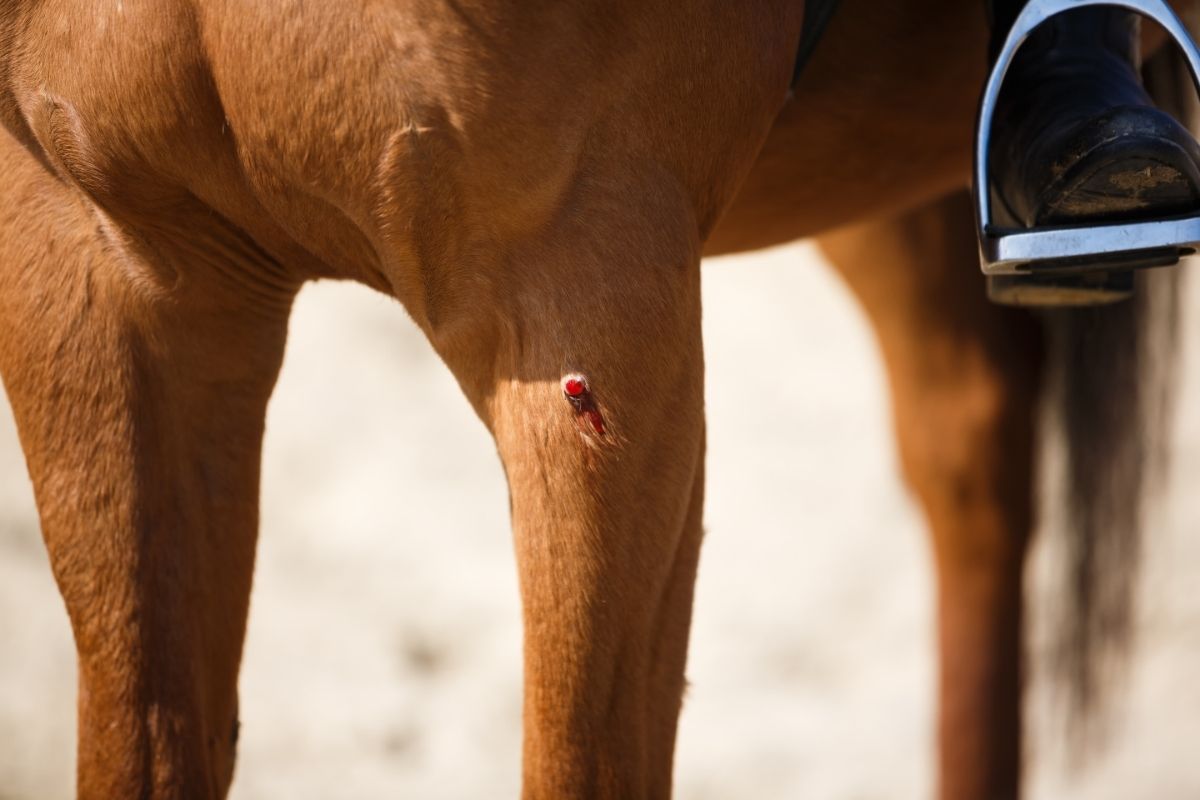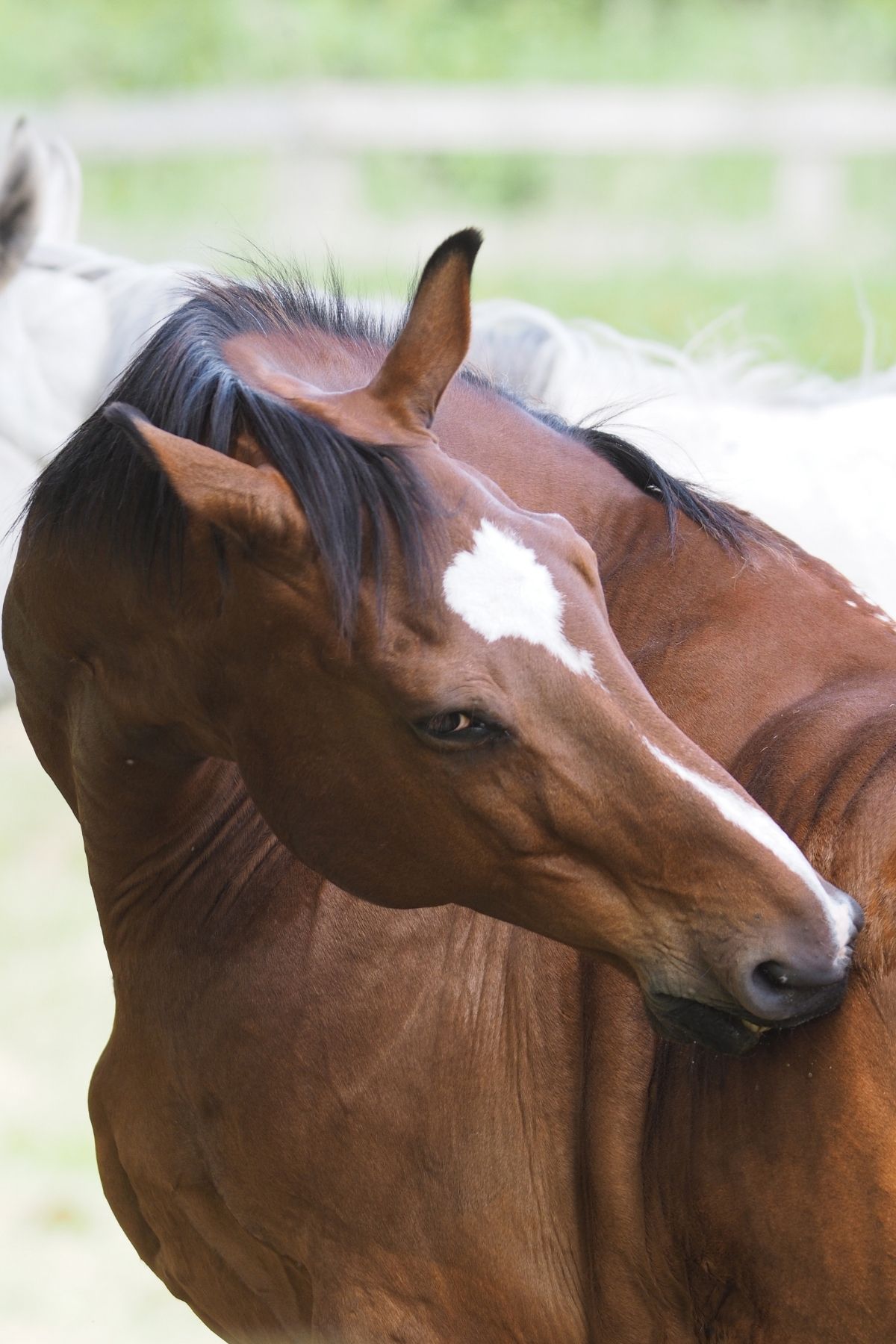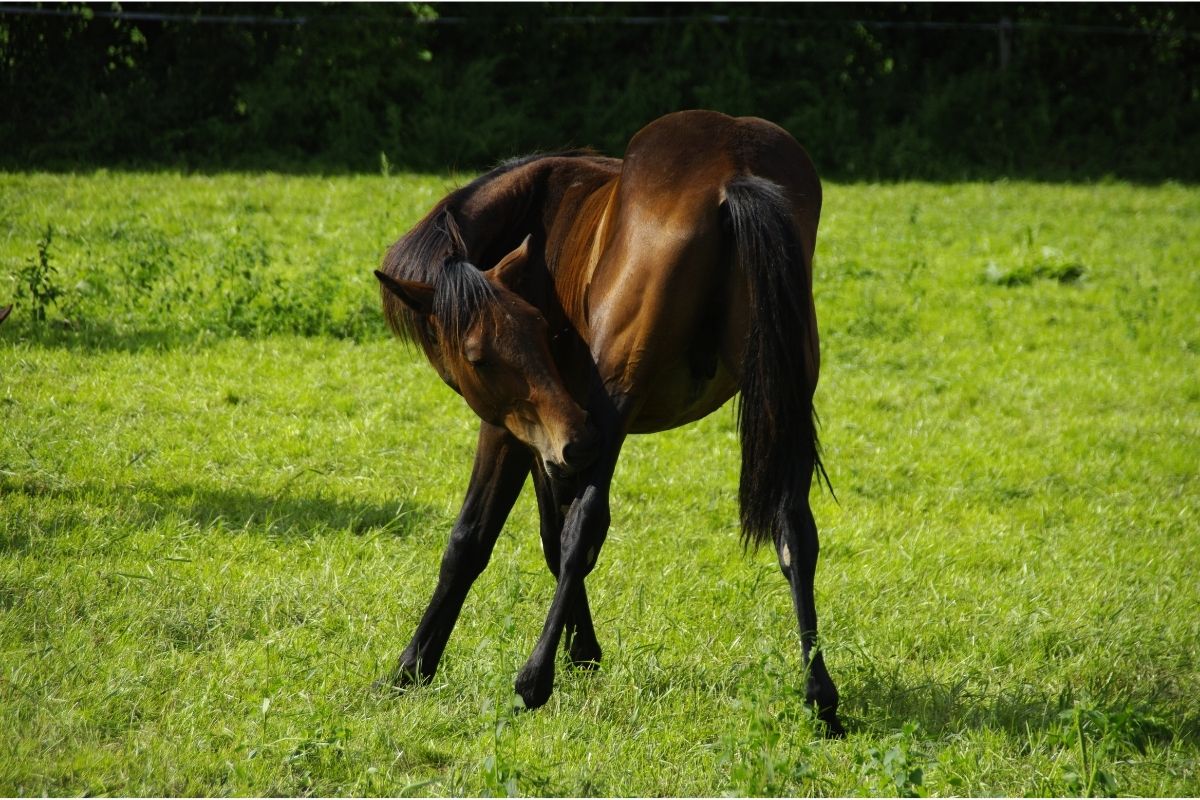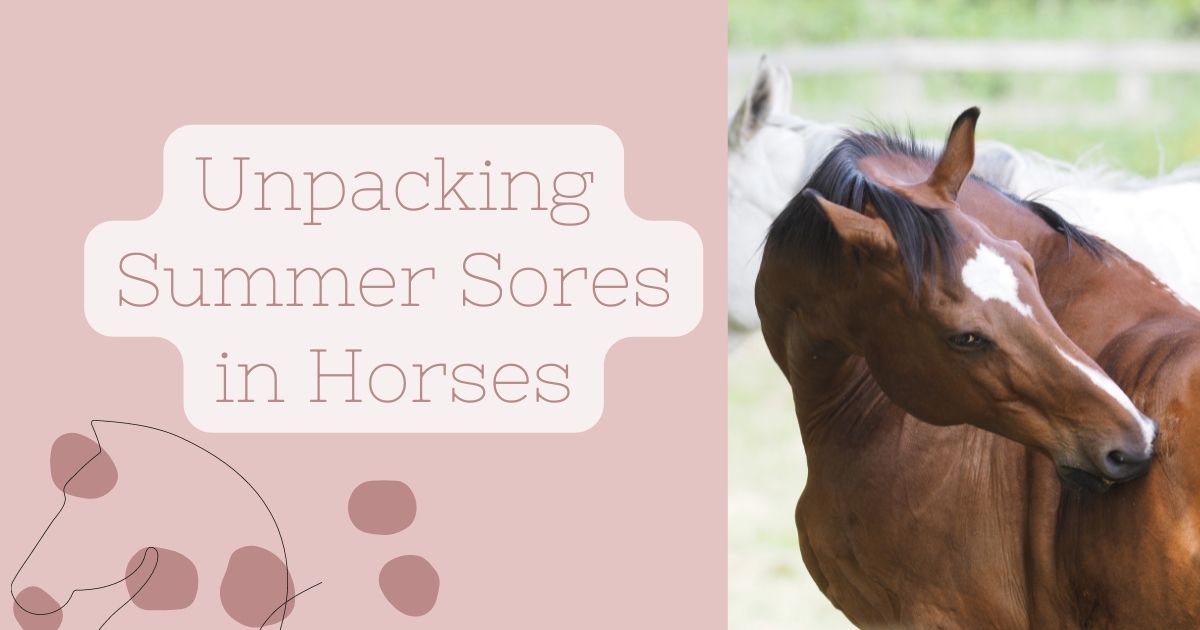What are Summer Sores in Horses?
Winter has finally given the reins to warmer summer days. It is time for summer hats, sunblock, and long lingering walks! But unfortunately for equine lovers, it can also be the season for pesky, painful summer sores rendering your horse feeling rather itchy and sore.
Summer sores are medically known as cutaneous habronemiasis and are a seasonal medical condition caused by the following three nematode species: 1) Habronema muscae, 2) Habronema majus, and 3) Draschia megastoma.
The medical definition of habronemiasis, according to Merriam and Webster, is as follows: “Infestation with or disease caused by roundworms of the genus Habronema and characterized in the horse by gastric tumors and inflammation or by summer sores” They can be most commonly found in the corners of the eyes, lower limbs and the urethral process of stallions and geldings.
Preexisting open wounds and sores are also a common site of infection.
These summer sores are a result of multifactorial processes between your horse’s immune system, the worm, and its intermediate hosts: the common house flies and stable flies. Even though these worms can inflame and aggravate the gastrointestinal system of the horse, primarily the stomach, the greatest threat posed is the invasion of wounds or softer and moister tissues of your horse.
You might also hear summer sores being referred to as jack sores, proud flesh or granular dermatitis, summer itch, and sweet itch.
Habronemiasis is also responsible for significant economic losses, as seen in sports horses where their athletic performance is impaired.

What do Equine Summer Sores Look Like?
Summer sores are, in essence, non-healing lesions of granulated tissue. The wound usually has mucopurulent discharge containing yellow calcified material, and even small rice-like larvae deposits can also be seen.
They may have blood-tinged fluid oozing from them and filled with red lumpy granulation tissue.
In more severe cases, the wound can be accompanied by necrotic lesions. The tissue usually has a yellowish-colored appearance.
Horses’ lower limbs, especially in the area extending from the fetlock to the coronary band, become affected as they are more prone to cuts and grazes, thus providing an ideal environment for habronema larvae.
The Causes of Summer Sores in Horses
As mentioned in the beginning, nematode worms are the main culprits of summer sores in equines.
Understanding the life cycle of these parasites is of paramount importance in regards to treating the wounds, preventing reinfection, and eradicating the parasite. Let’s take a look and see exactly how these nematodes cause these painful, itchy, and oozing, lesions in horses.
The adult worms reside in your horse’s stomach (rarely producing clinical signs), and from there, the eggs are passed into the manure, where they are ingested by flies such as stable flies or common house flies.
Upon being ingested by flies, the larvae then migrate to the fly’s mouthparts. When the flies feed on moist areas of your horse, such as the mouth area, they then subsequently deposit the eggs, which are then swallowed by the horse, and thus the routine life cycle occurs.
And here comes the tricky part! When the larvae though are deposited on tissues in the eye area or wounds present on the lower limbs, for example, this is considered an abnormal step in the routine life cycle.
The larvae cannot live in these tissues. But instead, a hypersensitivity reaction in the tissue is provoked by their presence from your horses’ immune system as it tries to fight off these invaders. And this exactly is where the problems unfortunately begin.
Since the larvae cannot develop into adult worms, they cause a severe local inflammatory reaction characterized by intense itching (pruritus), oozing, ulceration, and even necrosis.
As larvae migrate through the tissue even further damage and irritation is caused.
The formed lesions are characterized by rapid growth and will usually have your full attention within a few days. It will probably be that around this point, a call to your veterinarian will be needed.
How to Treat Summer Sores in Horses
But how can I help my beloved horse, we hear you ask and can anything be done? Let us explain further so I can answer your question and help you to make the best decision for your beloved equine friend.
Even though treating summer sores in horses is no easy task, it can be accomplished by combining a number of approaches and a sprinkle of patience and perseverance. Treatment is aimed at controlling the hypersensitivity reaction and eradicating the presence of the parasite.
Summer sores, even though possible, will very rarely heal on their own. During the winter months, the inflamed wounds may fade and appear to heal but be aware that once spring comes, they will unfortunately once again erupt.
The first step to take when attempting their treatment is to call your veterinarian to examine your horse and provide a definitive diagnosis. Habronemiasis can produce similar wounds and clinical signs to other pathologies such as growths and onchocerciasis, which are a lot more severe health conditions.
Diagnosis will be based on skin scrapings or a biopsy of the inflamed area and clinical signs, along with a detailed anamnesis.
Once a definitive diagnosis has been reached, it will be time to devise and implement a plan of attack! Powerful anti-inflammatory drugs such as glucocorticoids or even steroids can be used systemically or topically to clear up the inflammation.
Surgical debridement of the tissue may be required to help your horses’ tissues prepare for the healing process. Debridement will also remove any necrotic tissue from the wound and is a vital process in large and more chronic wounds.
Antibiotics may also be necessary in case of the presence of a secondary infection.
Ivermectin or Moxidectin will be also be used to kill the adult parasites that reside in your horse’s stomach. A repeat administration of either of these drugs may be needed after a month as the larvae carrying flies may reside in the horse’s environment for several weeks.
Intra-lesional injections can also be administered to help reduce the inflammation and destroy the larvae.
The final step will be to apply a fly-repellant ointment to discourage flies from gaining access to the open wound and causing subsequent irritation and contamination of the wound.
Our Top-Rated Fly Control Tips
Products that interrupt the life cycle of the flies before the beginning of the fly season are a great head start to fly control.
Starting early with control results in far better control and eradication of the developing fly population and larvae.
Feed thru fly control products essentially works in the horse’s manure. The active ingredients are not absorbed by your horse’s gastrointestinal system, but instead, they are released in the horses’ manure, thus preventing the development of flies and larvae and eradicating them.
In essence, any product that interrupts the development of flies also interrupts their life cycle and thus helps control their population in an effective manner.
Repelling sprays used around the barn’s parameters are also a great and efficient way for fly control.
Various fly repelling products in the forms of sprays, roll-ons, spot-ons, and ointments are also very beneficial and are applied to the horse to help keep flies as far away as possible. Fly masks, fly boots, and fly sheets can be used to protect your horse through coverage. You can choose either one of these covers depending on your horse’s tolerance and sensitivity to them.
Citronella oil and Eucalyptus oil are also effective essential oils in repelling flies and can be applied using a spray bottle if needed.
A word of caution when using essential oil. Always remember that these oils must be diluted and must under no circumstances be applied neat to your horse’s skin as they can cause irritation. Always avoid spraying near or in the eye area.
They can be diluted with various dilutants such as water, aloe vera gel, or even a mild base oil at a ratio of 30 milliliters of essential oil to 470 milliliters of water, gel, or base oil. If using a spray bottle to apply the oil, remember to always protect your horses’ eyes.

How to Prevent Equine Summer Sores
The most important and most effective step in preventing the occurrence of summer sores is (yep, you guessed it!!): fly control.
Even though this may seem a difficult and even impossible task at first glance, fret not, fellow equine lovers, there are more than a few ways flies can be controlled.
Manure is key in the process of fly control. Remember, this is where the eggs are passed and where the larvae can be found. From there, they can then spread to the environment and on to contaminating other horses too.
Any manure present in stalls, paddocks, and pastures, any excess feedstuffs, and wet materials all offer flies ideal breeding sites and subsequent hatching grounds for fly larvae. Thus, they should be monitored and cleaned out frequently.
Stalls should be cleaned out every day, and the paddocks should be cleaned a minimum of once per day. Ideally, they should be cleaned out twice per day, once in the morning and once later on near the end of the day.
Pastures can be cleaned a minimum of two times per week but bear in mind that the warmer and moister the climate is, the more frequent cleaning will have to be performed. In essence, pastures should be cleaned as often as possible.
Any feeds should be stored in tightly-sealed containers, and any spilled feed should be swept up and discarded.
Also, adding diatomaceous earth to your horse’s feed and possibly combining them with insect growth regulators (IGR) will help regulate any invaders.
Rubbish should be removed from the premises frequently throughout the day and disposed of in rodent-proof containers.
Compost piles can be used to kill fly maggots by maximizing their heat production through proper management. This practice is also known as hot composting and can destroy a wide range of pathogens too.
In the case that you have rain barrels, they should be emptied frequently of water (at least once per day) or covered appropriately, as any moisture will attract flies and larvae.
Insecticide fly traps and/or baits can be used to trap and kill flies.
Face masks for equines are also beneficial by not allowing the flies to access the softer tissues such as the eye and mouth area. If your horse tolerates these masks, they can be an ideal aid.
Fly sprays and repellents applied to the body of the horse can also provide adequate protection and help keep flies at bay.
New horses should not be turned into pastures before obtaining a fecal egg count. Ideally, horses should be dewormed before turning them into new pastures, and a fecal egg count should be obtained after deworming them too.
Fecal egg counts should be performed periodically to help determine if your horse/horses is/are a low, medium, or high worm shredder. This information can help you when devising a management plan as you will know what type of shredder your horse is and how frequently deworming should take place.
Regular deworming should be performed, thus killing adult worms and stopping the shedding of eggs in manure.
Prevention of summer sores is, in essence, a combination of good management and good hygiene practice. Fly control is an ongoing combined effort, and the more routinely and consistently it is practiced and maintained, the more efficient it becomes.
By combining all of the above, the risk of habronemiasis can be greatly reduced.

Sores be Gone!
There is no one-step solution to prevent summer sores in your horses, and unfortunately, the pesky flies will never be completely eliminated from your barn and stables. The most important message to be taken from here is that good housekeeping and regular deworming of your horse are the best tactics in fighting the presence of these nuisances.
By only providing horse protection but without maintaining a dry and clean environment will unfortunately not result in the maximum possible fly control. It may seem daunting at first, and the task list may be long, but the more consistently good hygiene is practiced, the more effective fly control will become.
The key to fly control is to keep your barns, stables, and pastures clean. Do not allow moisture to gather, and maintain a good manure processing program.
Use a combination of fly-control methods as well. The more, the merrier seems to fit here perfectly. Feed through larvicides can be your best friend in this instance by preventing the development of maggots combined with fly predators that feed on larvae in the manure, thus removing them completely from the horses’ environment.
Also, cooperate with your local veterinarian and devise a suitable deworming routine involving the periodic use of specialized deworming products containing either Ivermectin or Moxidectin whilst at the same time avoiding overuse that may lead to anthelminthic drug resistance.
As the saying goes, prevention is better than cure, and in the instance of cutaneous habronemiasis, it is the perfect phrase. Treating summer sores can be costly. It takes time and patience, along with a combination of medical approaches. It can be very draining to you as a horse owner and simultaneously very disheartening.
The summers are getting hotter, more humid, and longer, thus increasing the risks associated with habronemiasis and providing ideal environmental conditions for flies and their larvae.
This is why it is of utmost importance to be one step ahead and implement a high-standard hygiene plan/routine that will keep you and your beloved horse happy and will deter flies from negatively impacting your summer strolls.
There is nothing better than a carefree summer for you and your equine friend enjoying the countryside and sweet summer breeze together!!
